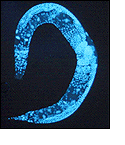|
 Previous Event | Next Event Previous Event | Next Event 
1998: Roundworm C. elegans Sequenced
 In December 1998, the first genome sequence of a multicellular organism, the roundworm Caenorhabditis elegans, was completed. In December 1998, the first genome sequence of a multicellular organism, the roundworm Caenorhabditis elegans, was completed.
C. elegans measures one millimeter in length and lives in dirt. It was the first animal – complete with nervous and digestive systems and a system for reproducing sexually – to have its genome deciphered. Also, like humans and other animals, C. elegans begins life as a single fertilized cell and passes through a precise program of embryonic development to become a fully-formed animal. C. elegans is easy to study because it is transparent; scientists can track every cell division and watch the worm’s body machinery in action.
C. elegans has already proven helpful in the study of development, neurobiology, and aging. Its complete genomic sequence was expected to provide insights on how the genomes of complex organisms function. The worm’s DNA sequence contains 97 million base pairs spread among six chromosomes. Structurally, these chromosomes are more like human chromosomes than those of bacteria or yeast. The worm’s genome has about 20,000 genes; about forty percent of them are similar to genes found in humans.
More Information
Reference:
Genome sequence of the nematode C. elegans: a platform for investigating biology. The C. elegans Sequencing Consortium. Science, 282: 2012-8. 1998. [Full Text]

To view this PDF, you will need Adobe Acrobat Reader. 
 Previous Event | Next Event Previous Event | Next Event 
Last Updated: April 7, 2008
|

